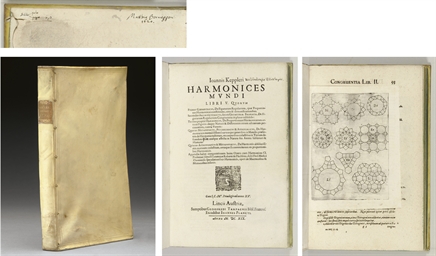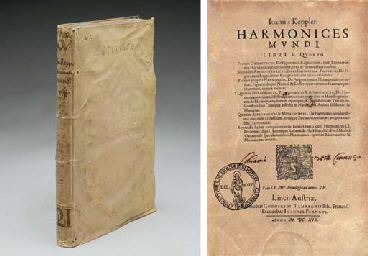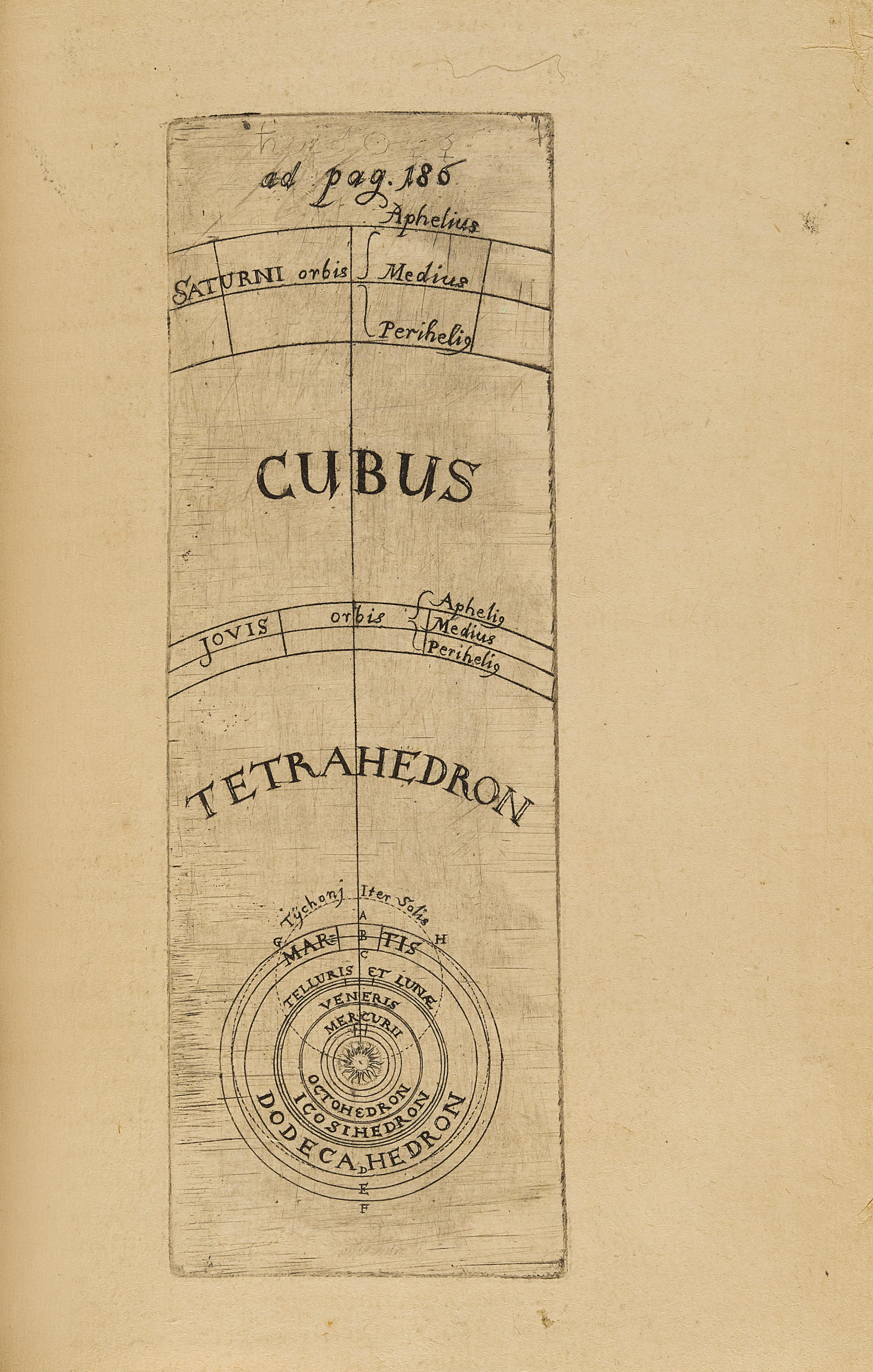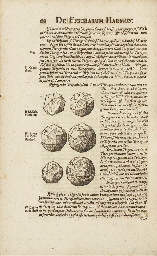KEPLER, Johannes (1571-1630). Harmonices mundi libri V . Linz: Johannes Plank for Gottfried Tampach, 1619. 2 (300 x 189mm). First state of general title with printer's device and without text beginning 'Accessit nunc...', five section titles, dedication to King James I of England (*2r-*4r) later suppressed by Kepler and absent from some copies, errata leaf at end. Printer's device on title, 6 engraved plates (two printed on one leaf), numerous woodcut text diagrams and illustrations after Wilhelm Schickard, woodcut musical notation in Book III, ornamental and factotum initials, ornamental headpiece. (Light dampstaining, resulting in fraying of final leaf, some light browning, two short tears into text, Ii2.3 torn at upper inside margin.) Modern blindstamped calf, red spine label, speckled edges. FIRST EDITION of Kepler's great cosmological treatise, containing the third law of planetary motion. An ardent Copernican, Kepler accepted that the sun was near the centre of the universe, but he went farther, attributing physical force to the sun. In his earliest published work, the Mysterium cosmographicum (1596) Kepler had investigated the number, the dimensions, and the motions of the orbs; in the Harmonices mundi he explains the harmony of the universe, the natural correspondence between the cosmos and the individual. He imposes a neo-Platonic theology on stringent geometric analysis of the universe. In contrast to the poetic cosmic harmony propounded by his contemporary Robert Fludd, of whom Kepler was openly critical, Kepler provided 'a detailed and coherent explanation of the structure of the cosmos in terms of a divine harmony based on geometry'. He investigates harmony in four areas: geometry, music, astrology and astronomy. Books I and II are concerned with the geometrical foundation of universal harmony, beginning with a detailed exposition of Euclid's Elements . He discusses polygons and polyhedrons and -- for the first time -- stellated dodecahedrons, which Louis Poinsot was to rediscover in 1810; four of them are today known as Kepler-Poinsot solids. Book III investigates harmonic proportions and music theory, while Book IV contains the fullest expression of his astrological views. He discusses the influence of the zodiac on the human soul and sets forth his belief in an animistic earth-soul sympathetic to the heavens. Book V is devoted to astronomy and contains Kepler's third law of planetary motion, which stated that 'the square of the period of time of a planet is proportional to the cube of its mean distance from the sun' (Dibner); it remains valid today. Kepler dedicated the Harmonices mundi to King James I of England, as someone capable of reconciling the Protestants and the Catholics. When James's son-in-law proclaimed himself Elector of the Palatinate in opposition to the Emperor, Kepler's patron, in 1620, Kepler wisely suppressed the dedication and it is absent in some copies. Caspar 58; Dibner Heralds of Science 6; Grolier/Horblit 58; Houzeau & Lancaster 11832; Zinner 4737; Norman 1207.
KEPLER, Johannes (1571-1630). Harmonices mundi libri V . Linz: Johannes Plank for Gottfried Tampach, 1619. 2 (300 x 189mm). First state of general title with printer's device and without text beginning 'Accessit nunc...', five section titles, dedication to King James I of England (*2r-*4r) later suppressed by Kepler and absent from some copies, errata leaf at end. Printer's device on title, 6 engraved plates (two printed on one leaf), numerous woodcut text diagrams and illustrations after Wilhelm Schickard, woodcut musical notation in Book III, ornamental and factotum initials, ornamental headpiece. (Light dampstaining, resulting in fraying of final leaf, some light browning, two short tears into text, Ii2.3 torn at upper inside margin.) Modern blindstamped calf, red spine label, speckled edges. FIRST EDITION of Kepler's great cosmological treatise, containing the third law of planetary motion. An ardent Copernican, Kepler accepted that the sun was near the centre of the universe, but he went farther, attributing physical force to the sun. In his earliest published work, the Mysterium cosmographicum (1596) Kepler had investigated the number, the dimensions, and the motions of the orbs; in the Harmonices mundi he explains the harmony of the universe, the natural correspondence between the cosmos and the individual. He imposes a neo-Platonic theology on stringent geometric analysis of the universe. In contrast to the poetic cosmic harmony propounded by his contemporary Robert Fludd, of whom Kepler was openly critical, Kepler provided 'a detailed and coherent explanation of the structure of the cosmos in terms of a divine harmony based on geometry'. He investigates harmony in four areas: geometry, music, astrology and astronomy. Books I and II are concerned with the geometrical foundation of universal harmony, beginning with a detailed exposition of Euclid's Elements . He discusses polygons and polyhedrons and -- for the first time -- stellated dodecahedrons, which Louis Poinsot was to rediscover in 1810; four of them are today known as Kepler-Poinsot solids. Book III investigates harmonic proportions and music theory, while Book IV contains the fullest expression of his astrological views. He discusses the influence of the zodiac on the human soul and sets forth his belief in an animistic earth-soul sympathetic to the heavens. Book V is devoted to astronomy and contains Kepler's third law of planetary motion, which stated that 'the square of the period of time of a planet is proportional to the cube of its mean distance from the sun' (Dibner); it remains valid today. Kepler dedicated the Harmonices mundi to King James I of England, as someone capable of reconciling the Protestants and the Catholics. When James's son-in-law proclaimed himself Elector of the Palatinate in opposition to the Emperor, Kepler's patron, in 1620, Kepler wisely suppressed the dedication and it is absent in some copies. Caspar 58; Dibner Heralds of Science 6; Grolier/Horblit 58; Houzeau & Lancaster 11832; Zinner 4737; Norman 1207.




.jpg)

.jpg?w=400)



.jpg)
.jpg)

.jpg)

Testen Sie LotSearch und seine Premium-Features 7 Tage - ohne Kosten!
Lassen Sie sich automatisch über neue Objekte in kommenden Auktionen benachrichtigen.
Suchauftrag anlegen